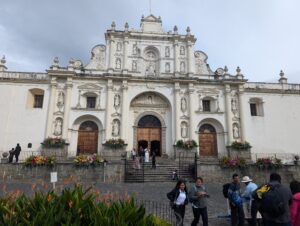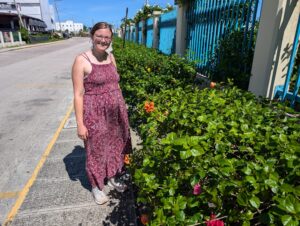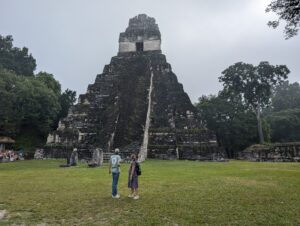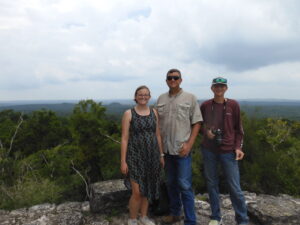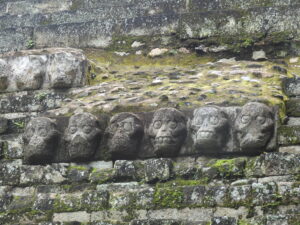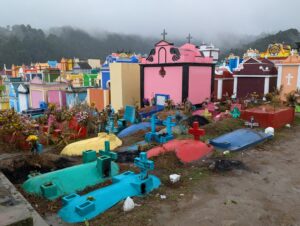Travel Tips
Belize & Guatemala Travel Advice
By no means did we see everything there is to see in Guatemala. We saw just a couple of places for a couple of days in Belize, and we saw only Copan in Honduras. I’ll share my experiences here, with the understanding and disclaimer that they are a bit limited. It should also be noted that while Andrew and I were comfortable with a bit more immersion into local practice and budget traveling, Audrey began this trip over 30 weeks pregnant. These things were factors in our decision making.
Belize
Belize is a Caribbean country. Most of its Central American neighbors have Pacific and Caribbean coasts, but Belize and El Salvador have just one. Belize is the only former British colony in Central America, so English is widely spoken there. Belize and Costa Rica share a reputation for safety, stability, and welcoming North American tourists. As such, while travel costs in these countries is still inexpensive compared to many destinations in America, you will pay a “perceived peace and stability premium” over Guatemala, Honduras, and Nicaragua. This is true across the board, and seems to apply to food, accommodations, and excursions.
Unless visiting on a cruise, most people will arrive in Belize at the international airport in Belize City. It’s a small airport. You have to go outside to get on or off the plane. Navigating the airport is pretty straightforward, though. I did not do enough research to learn ahead of time that Belize City is not, itself, a tourist destination. There really is no need to do anything beyond passing through en route to somewhere else. Accommodations were not particularly cheap, and there was not much to see or do in the city. If you plan to spend some time in Belize, either go on out to one of the islands, or check out a city further up or down the coast. We can only speak about Caulker, because that’s the only place we went in Belize other than the Belize City. Caulker was the smaller, less expensive option of the cayes easily accessible by water taxi.
Belize – Money
My usual practice is to have some U.S. currency with me for emergencies and passing some land border crossings. Otherwise, I carry a couple of ATM cards and a couple of credit cards. I have ATM cards that don’t charge big fees, and also refund other banks’ ATM fees. So my plan is usually to seek out a cash machine as soon as I arrive in a new country and extract some currency directly.
I did not find an ATM in the Belize City airport. The airport is quite a ways from town, so you need a ride. I usually just catch Uber, which buys me more time to find an ATM. No cash changes hands when using Uber. They don’t have Uber in Belize, though, so I was worried I would need some Belizean money. Fortunately, pretty much everyone in Belize accepts American dollars. Further, since Belizean dollars are pegged at B2$/$1, the conversion is very easy and you don’t get hosed on exchanges or foreign purchases. So in Belize, finding an ATM right off is not that important if you have some U.S. currency on hand. Our cab driver stopped at an ATM on the way to our intended motel, so that was resolved quickly.
Belize – Transportation
Since there is no Uber in Belize, and there does not seem to be another ride sharing app alternative as in Thailand, Malaysia, Singapore, India, Nepal, etc., you end up relying on taxis to traverse in-town distances farther than you are willing to walk. It is useful to note that all licensed taxis in Belize have green license plates. They seem to have a more or less set rate based on zones of the city, though some try to get around this by collecting more than one passenger in different places. They will occasionally give you a bit of a discount for allowing them to operate this way, but it must be negotiated in advance. I do not think this procedure is completely within legal bounds.
Getting out to the cayes from Belize City requires making your way to the easternmost point of the town, and then hopping on one of the many different water taxis operating from there. You can get to Caulker or Ambergris, as well as Chetumal, Mexico. The wait can be warm and muggy in the afternoon or even late morning, as there is not an air conditioned waiting area. Round trip tickets from Belize to Caulker and back ran us $39 U.S. apiece. It would have been $25 one way. It is important to note that these water taxis seem to operate only from about 8:30-5:00.
Belize’s bus system has several lines running the length of the country East-West and North-South. A few of these offerings are express trips, but most make a lot of stops. They buses used are retired U.S. school buses, often quite well worn. They aren’t quite as decorative as the so-called “chicken buses” in Guatemala, but they are about equivalent. It took us about 3-4 hours to get from Belize City to Benque Viejo del Carmen, about 3 km from the Guatemala line, and cost B$11 or B$12 per person. These buses leave from a terminal not all that far from the water taxi out toward the point where Belize City juts into the Caribbean. There are also tour buses that offer far more comfort and avoid the gap between Benque and Melchor de Mencos Guatemala. They are also a bit faster, but cost something closer to $40-$50 U.S. at the time of this writing. We have no experience with this service.
Belize – Food
We ate at mostly local sit-down restaurants in Belize City. These were not really a bargain, and seemed about on par with what you would pay to eat at a cafe in the U.S. Many of our fellow hostel guests were angry about the cost of local restaurants in Belize City. The food was fine, but not spectacular. There were quite a few seafood restaurants, and several Chinese establishment. Steaks seemed to be of the type you often find in Latin America – quite a bit thinner and tougher than American steaks, but still with good flavor.
Our plan was usually to eat in the motel for breakfast, snack during the day, and eat a restaurant meal for supper. We found a large grocery that had what we needed for breakfast and snacks. It wasn’t particularly cheap, either, but not exorbitant. It was more expensive than what you would expect to see in Mexico or Central America.
Once Andrew and I were out on Caulker Caye, we did not notice the prices to be any better or worse than they were in Belize City. I thought this strange, since we were actually out in tourist country. Again, food was not particularly cheap, but not really expensive either. The food was reasonably good. We did try a couple of frozen drinks, which tasted good but did not seem to have much alcohol content. That was ok by us, as we are not heavy drinkers, anyway. Travelers with other priorities might look at this differently. Since we did not stay on Ambergris, I cannot comment on prices there, other than that it has a reputation for being a bit more expensive than Caulker.
Belize – Accommodations
As with the food, Belize City underwhelmed us as value travelers. The first budget room I had reserved on Booking.com failed to honor our reservation. We were left to do some quick shopping. I found a clean but basic room. It was $80 U.S. per night, not much different from what you might expect to pay at a motel in a smaller, non-tourist city in the U.S. I was expecting lower prices in Belize, or at least a nicer facility.
We managed to find a hostel, again on an emergency basis on our way back through Belize City. We ended up with a private room by default (there were two of us, and the room the assigned us had only two beds. We had air conditioning, but only between 7 p.m. and 7 a.m. We paid $35 per bed, per night, which seemed rather high for a hostel in a non-resort area. We had some good visits we folks in the hostel, though, and the higher end facilities were even more expensive.
After yet another booking fiasco, we found our last second motel on Caye Caulker to be our best room deal in Belize. We paid $58 per night for a clean, comfortable room with good air conditioning and wifi. Our resort area motel turned out to be cheaper – and better – than any place we stayed in Belize City. It is not fancy, but I would recommend Enjoy Motel on Caye Caulker as a solid budget offering.
Guatemala
Our overall trip plan was flexible, and we intended to use Belize as a safety valve – a place to go when we ran out of things to do in Guatemala, or just didn’t want to stay there anymore. It turned out that everyone in our party really enjoyed our time in Guatemala. We spent the vast majority of our time in there, and found it to be a better deal across the board than Belize.
Guatemala is a much larger country than Belize. Although it has a reputation (and a state department report) suggesting one might have safety concerns, we did not find this to be the case. U.S. state department reports are notoriously conservative, and sometimes recommend against visiting a place for political, rather than safety concerns. Guatemalans were very friendly, and the only place we noticed any danger was when driving our rented car on Guatemalan roads.
Like most Central American countries, Guatemala has a Pacific and Caribbean coast, though the latter is much smaller. It has central highlands with some very tall volcanoes. We found the roads in the northern part of the country to be generally better than other areas, though nearly all roads were two lane. Posted speed limits were often 60 kmh or slower, though no one obeyed the signs. Speeds tended to be limited more by road and traffic conditions, which were often abysmal. All of these make travel in Guatemala relatively slow, even when distances are short.
Guatemala – Money
Guatemala’s currency is named after the colorful quetzal bird. At the time of our visit, Guatemalan quetzales traded at about Q7.73 to $1, making conversions a little awkward and purchase calculations cumbersome. Quite a few businesses catering to tourists accepted credit cards, but cash was and is a much surer thing. Guatemalan businesses tended not to accept U.S. dollars, as they had in Belize. We were always able to find ATMs when we needed them. There were also money changers working the land border crossing at Melchor de Mancos both times we crossed. Their exchange rates were predictably bad, and we were not able to convince them to bargain.
Guatemala – Transportation
As was the case in Belize, we found no metro, trains, or rail service of any kind in Guatemala. Major tourist areas are served by more comfortable tour buses, but we elected to start by using colectivos and chicken buses. Colectivos are just vans or minibuses that locals use to get from point A to point B. These stop often and pick up locals going to work, or to town to shop or sell wares. They tend to have a driver and an assistant. The deputy collects fares, ties baggage to the roof, and generally coordinates shuffling passengers around when needed. I have seen these colectivos in just about every Latin American country I have visited. Although they are not always crowded, the deputy will cram in as many people as will physically fit. Sometimes you might think the bus full, and the deputy will find a way to fit a few more in. At one point, we were in a colectivo with 26 people. I think people were calling these microbuses rather than colectivos in Guatemala, but they are the same thing.
Retired American school buses of 1970s vintage make up another major component of Guatemalteco public transportation. Tourists refer to these as “chicken buses,” as they seem likely to stop for anything – even animals. People have also been known to carry livestock with them on this kind of bus. Locals, however, do not use this term, and may not know what you’re talking about if you ask in Spanish how to find the chicken bus. It’s best to look for a bus terminal or designated stop. Like colectivos, chicken buses have a driver and a deputy who is responsible for money collection, maintaining order, and otherwise being helpful. Many times, these fellows will help you look for your stop if you are not familiar with it, provided you tell them where you are going. Do not expect to have this conversation in English, though.
Both colectivos and chicken buses tend to be extremely low cost. You might be asked to pay a tourist rate, but even that will seem like a pittance. We rode a colectivo from Flores to Melchor de Mencos – a 2 hour drive – for a whopping Q30 ($4). Other trips cost Q10 or Q15 depending on how far we were heading.
At 7 ½ months pregnant, Audrey was not too fond of the idea of making all day trips in colectivos and chicken buses. At her behest and her expense, we rented a car in Flores. This was extremely inexpensive. It cost just $133 to rent a car for an entire week. Fuel prices were less in Guatemala than Belize, though it was still more expensive to buy fuel in Guatemala than Lubbock, Texas. After conversion, Guatemalan fuel usually hovered at around $4/gallon.
Renting the car gave us the freedom to go where we wanted, when we wanted. It also gave us a built in place to store our packs and other goods, even when we did not yet have a motel room. The only real detractor was the ordeal of navigating Guatemalan roads. The roads have random pot holes, some very deep. We had to ford a river once on the Pan-American Highway. There are harsh speed bumps everywhere, forcing to you to nearly a complete stop more often that seems necessary. Even at a near stop, the vehicle frame will still often scrape the speed bump.
The roads themselves are often shaped like pretzels, or some random batch of noodles thrown onto the ground. Blind corners and sharp turns mean that trucks must go especially slow, often less than 10kph. The roads are covered with rickshaws and motor bikes along with the standard bevy of Toyota Hi-Luxes, Volkswagen Beatles, and various other vehicles of random vintages. Everyone else passes slow moving vehicles when they have a chance – or sometimes when it seems they might have a chance. Drivers are faced with the choice of remaining behind the truck doing 10kph, or chancing passing at times when you aren’t quite certain about the presence of oncoming traffic. I opted for the latter, and survived. Andrew and Audrey often called into question the safety of my driving. This much is certain: driving in Guatemala was not for the faint of heart.
Guatemala – Food
Food was generally good and inexpensive. I am not a foodie, and did not do any excursions based specifically on food, though these were available. We usually ate at “mom and pop” cafe type places for supper. They often had foods typical of Central American countries such as pupusas and boleadas. Tourist towns like Flores and Antigua had a broader variety of restaurants, some of which were a bit more expensive. See my article on Chichicastenango for a few other specific foods we tried.
Guatemala – Accommodations
I have three main minimum criteria for accommodations when traveling on a budget. Rooms 1) should be clean, 2) should have wifi, and 3) should have air conditioning if below 5,000’ elevation. We often found hostels and basic accommodations that met those criteria for about $17 U.S. per night. There were times when Audrey preferred to stay at places a bit nicer than a hostel or AirBnB with a shared bathroom. We often found motels that were or had been very nice at some time in the past, but just looked dated. In Antigua, we found these dated, but nicer motels to run about $50-$70 U.S. per night. In other towns they were less. I thought the “dated but nice” motels were a good bargain. Had Stephanie been along on the trip, she would have been happy to stay in such places.
I should also note here that many lodging facilities in Guatemala that are advertised as motels are not full service motels. Very often, venues that advertise on sites such as booking.com or AirBnB are simply people remotely renting out rooms. Some have a fairly automated entry procedure, but many are not professionally operated. On several occasions, we encountered rooms with no staff on hand. Multiple times, we had confirmations from booking.com of a room, only to receive a call or message sometime later – once as late as the afternoon we were supposed to check in – that there had been some conflict and the room was “double booked.” I would have to go find another place. Let the traveler beware that receiving a reservation comfirmation does not necessarily confirm that you have a place to sleep for the night. You may not know for sure until you get there. All the more reason to arrive during daylight hours.
Honduras
We only spent two nights and about a day and a half in Honduras, and only visited Copan Ruinas. Our stay there was pleasant. We had a “dated but nice” motel called Motel Acropolis Maya. I would highly recommend this motel, which is in a nice location just a block from the main village square. It has secured parking beneath the building, a pleasant courtyard, and a small rooftop swimming pool.
Our experience with restaurants in Copan Ruinas was about the same as in Guatemala. If there was any difference, it may have been that the food was even cheaper in Honduras, despite our staying in a tourist town.
We did not have trouble accessing cash at an ATM in Copan Ruinas, but other travelers told us they had been to several other ATMs all of which had been out of cash. I do not know if this was a common problem, but I found it worth noting.
I enjoyed my visit to Copan Ruinas enough that, with some caution, I would like to visit some other parts of Honduras on a future trip.

